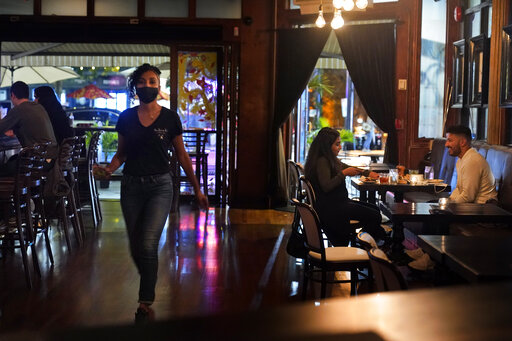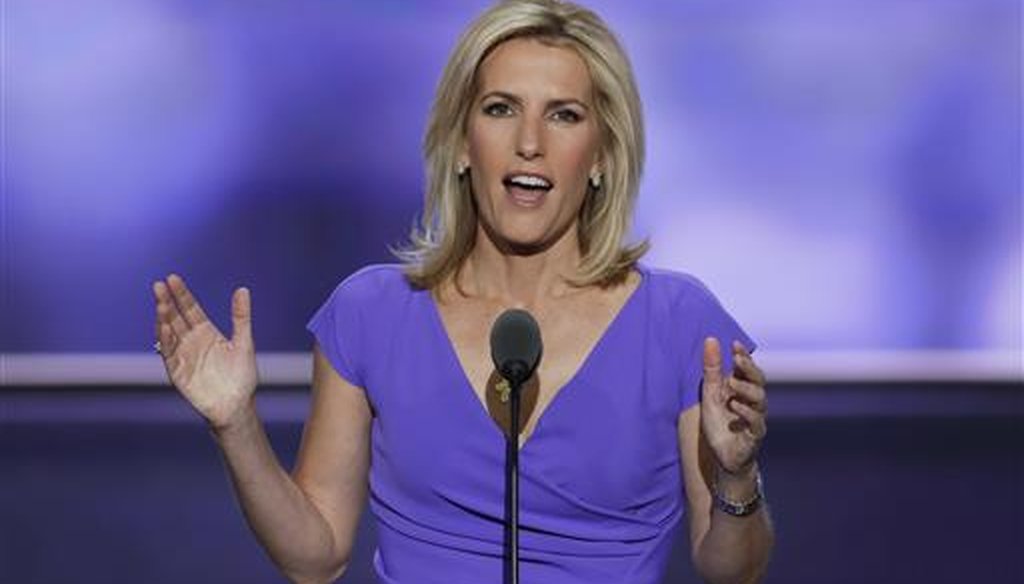



Fox News host Laura Ingraham speaks during the Republican National Convention in Cleveland on July 20, 2016. (AP/Applewhite)
The coronavirus can spread during restaurant dining as patrons take off their masks to eat or drink. Indoor restaurants without spaced-out seating are considered risky.
A September CDC report found a link between testing positive for the coronavirus and going to locations with on-site eating and drinking options, such as restaurants.
A November modeling study published in Nature suggested full-service restaurants are among the types of public places most responsible for the spread of the coronavirus.
Fox News host Laura Ingraham downplayed the risk of contracting the coronavirus while dining at a restaurant, wrongly claiming restrictions on eating out are not supported by science.
"You know what the biggest lie is, is that restaurants are spreaders of COVID," Ingraham told host Sean Hannity during the handoff between their TV shows. "There's no science for that."
The Dec. 8 comment came after Hannity made reference to Ingraham’s on-air interview the previous day with a Los Angeles restaurant owner. The owner, Angela Marsden, had posted a viral video criticizing county officials for suspending outdoor dining.
Hannity later specified that he was talking about "outside" dining in California. But Ingraham’s claim about restaurants was far more sweeping — and more wrong. It’s inaccurate to say that "there’s no science" to show "restaurants are spreaders of COVID."
"There is a lot of information showing that restaurants are a high-risk environment," said Emily Landon, an epidemiologist and associate professor of medicine at the University of Chicago.
"Anytime people congregate, there exist increased opportunities for transmission should someone be infected," added Jeffrey Shaman, a professor of environmental health sciences at Columbia University. "A restaurant is no different."
Fox News did not offer comment for this fact-check.
The risks associated with dining out vary based on the safety precautions the restaurants take and the coronavirus situation in their geographic areas. Many restaurants have become safer over time, but case surges in many states make running into an infected person more likely.
"It’s hard to make universal claims because the pandemic is different in different parts of the country and even in different parts of the state," said Amesh Adalja, a senior scholar at the Johns Hopkins University Center for Health Security. "In some parts of the country, restaurants aren’t driving cases. In others, they have been identified in case investigations."
City data in Washington, D.C., for example, has shown restaurants and bars to be among the most common places for virus spread. Data in and around Los Angeles has been less clear.
Still, there’s plenty of evidence that COVID-19 has and can spread at restaurants — and especially at those that let groups of people congregate indoors without masks.
"Modeling studies have indicated that restaurants are high-risk environments for COVID-19 transmission," said Jason McDonald, a spokesperson for the Centers for Disease Control and Prevention. "In places like restaurants, people remove their masks to consume food and beverages, which increases the risk of transmission."
One CDC report in September, based on a survey of 314 symptomatic people who got tested for the coronavirus in July, found a link between testing positive for the coronavirus and going to locations with on-site eating and drinking options, such as restaurants.
The authors wrote that those with positive test results were "approximately twice as likely to have reported dining at a restaurant" than those who tested negative.
In a November study published in Nature, researchers at Stanford University and Northwestern University analyzed anonymized cell phone mobility data from 10 U.S. cities from March to May.
Full-service restaurants, gyms and other crowded places accounted for a disproportionate share of COVID-19 infections, the study’s simulations showed. "Restaurants were by far the riskiest places," Stanford’s Jure Leskovec, an author of the report, told reporters in November.

Patrons enjoy food and drink at The Brass Rail in Hoboken, N.J., on Nov. 11, 2020. (AP)
Dining outdoors is safer than dining indoors, the CDC says, and restaurants with spaced out tables and limited guests are less risky than restaurants that aren’t keeping patrons apart.
The virus is mostly spread from close physical contact, when people are exposed to respiratory droplets sent into the air as an infected person coughs, sneezes, talks, laughs or breathes.
But there’s growing evidence that infections may have also come from tiny airborne particles, especially in "enclosed spaces that had inadequate ventilation," the CDC says. Shaman cited one recent study from South Korean researchers that looked at airborne spread in a restaurant.
The researchers examined the origins of one June cluster at a restaurant in the city of JeonJu. They found that, because of the way air was circulated in the restaurant, one person contracted the virus after just five minutes of exposure to an infected diner more than 20 feet away.
Other studies have indicated indoor spaces carry higher risks of spread. The Atlantic highlighted one that showed the odds of transmission were nearly 20 times higher in closed spaces than in open-air environments. Landon shared with PolitiFact a powerpoint created for Illinois officials that listed several other studies, such as one examining an early outbreak on a cruise ship.
Restaurants can reduce the chance of virus spread. Shaman recommended that they minimize or end indoor dining, limit tables and space them out, require waiters to wear gloves and masks, increase ventilation and keep surfaces clean. He also suggested that restaurants take down contact information for those who dine in case contact tracing needs to be performed.
Ingraham said, "You know what the biggest lie is, is that restaurants are spreaders of COVID. There's no science for that."
In fact, plenty of evidence suggests restaurant dining has helped spread the coronavirus. Places that allow indoor dining and don’t follow safety protocols are considered especially unsafe.
We rate Ingraham’s statement False.
RELATED: Laura Ingraham wrong about 'no real scientific basis' for social distancing
Media Matters for America, "Laura Ingraham: 'You know what the biggest lie is, is that restaurants are spreaders of COVID.'" Dec. 8, 2020
Various searches on TVEyes, accessed Dec. 9, 2020
Georgia Tech University, "COVID-19 Event Risk Assessment Planning Tool," accessed Dec. 9, 2020
Los Angeles Times, "Infected after 5 minutes, from 20 feet away: South Korea study shows coronavirus’ spread indoors," Dec. 9, 2020
Eater, "Indoor Dining Is Fastest-Growing Source of COVID-19 Spread in New York, State Says," Dec. 9, 2020
Eater, "In a 4-Month Sample, D.C. Traces 14 Percent of COVID-19 ‘Outbreaks’ to Restaurants," Dec. 7, 2020
CNBC, "Dr. Scott Gottlieb: ‘I will not eat indoors in a restaurant’ because the Covid risk is too high," Dec. 7, 2020
Yahoo News, "LA restaurant owner rips mayor over 'arbitrary' COVID restrictions," Dec. 7, 2020
Eater, "Where Is the Data to Support Closing Outdoor Dining in LA? It’s Complicated," Dec. 1, 2020
Journal of Korean Medical Science, "Evidence of Long-Distance Droplet Transmission of SARS-CoV-2 by Direct Air Flow in a Restaurant in Korea," Nov. 30, 2020
ABC7 Eyewitness News, "How much are restaurants contributing to the spread of COVID-19 in LA County?" Nov. 25, 2020
The Atlantic, "Don’t Eat Inside a Restaurant," Nov. 20, 2020
Centers for Disease Control and Prevention, "Considerations for Restaurant and Bar Operators," Nov. 18, 2020
Forbes, "There's No Denying The Evidence: Restaurants And Bars Are Helping Spread COVID-19," Nov. 15, 2020
Nature, "Mobility network models of COVID-19 explain inequities and inform reopening," Nov. 10, 2020
The Washington Post, "These venues are high-risk areas for spreading the coronavirus, model suggests," Nov. 10, 2020
The New York Times, "Limiting Indoor Capacity Can Reduce Coronavirus Infections, Study Shows," Nov. 10, 2020
Stat News, "Restaurants and gyms were spring ‘superspreader’ sites. Occupancy limits could control Covid, new study predicts," Nov. 10, 2020
Centers for Disease Control and Prevention, "How COVID-19 Spreads," Oct. 28, 2020
Centers for Disease Control and Prevention, "Community and Close Contact Exposures Associated with COVID-19 Among Symptomatic Adults ≥18 Years in 11 Outpatient Health Care Facilities — United States, July 2020," Sept. 11, 2020
Centers for Disease Control and Prevention, 'Clusters of Coronavirus Disease in Communities, Japan, January–April 2020," September 2020
CNBC, "This chart shows the link between restaurant spending and new cases of coronavirus," June 26, 2020
Proceedings of the National Academy of Sciences of the United States of America, "The airborne lifetime of small speech droplets and their potential importance in SARS-CoV-2 transmission," May 13, 2020
Medrxiv, "Closed environments facilitate secondary transmission of coronavirus disease 2019 (COVID-19)," April 16, 2020
National Institutes of Health, "Transmission potential of the novel coronavirus (COVID-19) onboard the diamond Princess Cruises Ship, 2020," Feb. 29, 2020
PolitiFact, "Tucker Carlson distorts new CDC report, makes false mask claim," Oct. 15, 2020
PolitiFact, "What we know about the airborne spread of the coronavirus," Sept. 25, 2020
Email interview with Jason McDonald, spokesperson for the Centers for Disease Control and Prevention, Dec. 10, 2020
Email interview with Emily Landon, associate professor of medicine and executive medical director at University of Chicago Medicine, Dec. 10, 2020
Email interview with Amesh Adalja, senior scholar at the Johns Hopkins Center for Health Security, Dec. 9, 2020
Email interview with Jeffrey Shaman, professor of environmental health sciences at the Columbia University Mailman School of Public Health, Dec. 9, 2020
In a world of wild talk and fake news, help us stand up for the facts.
